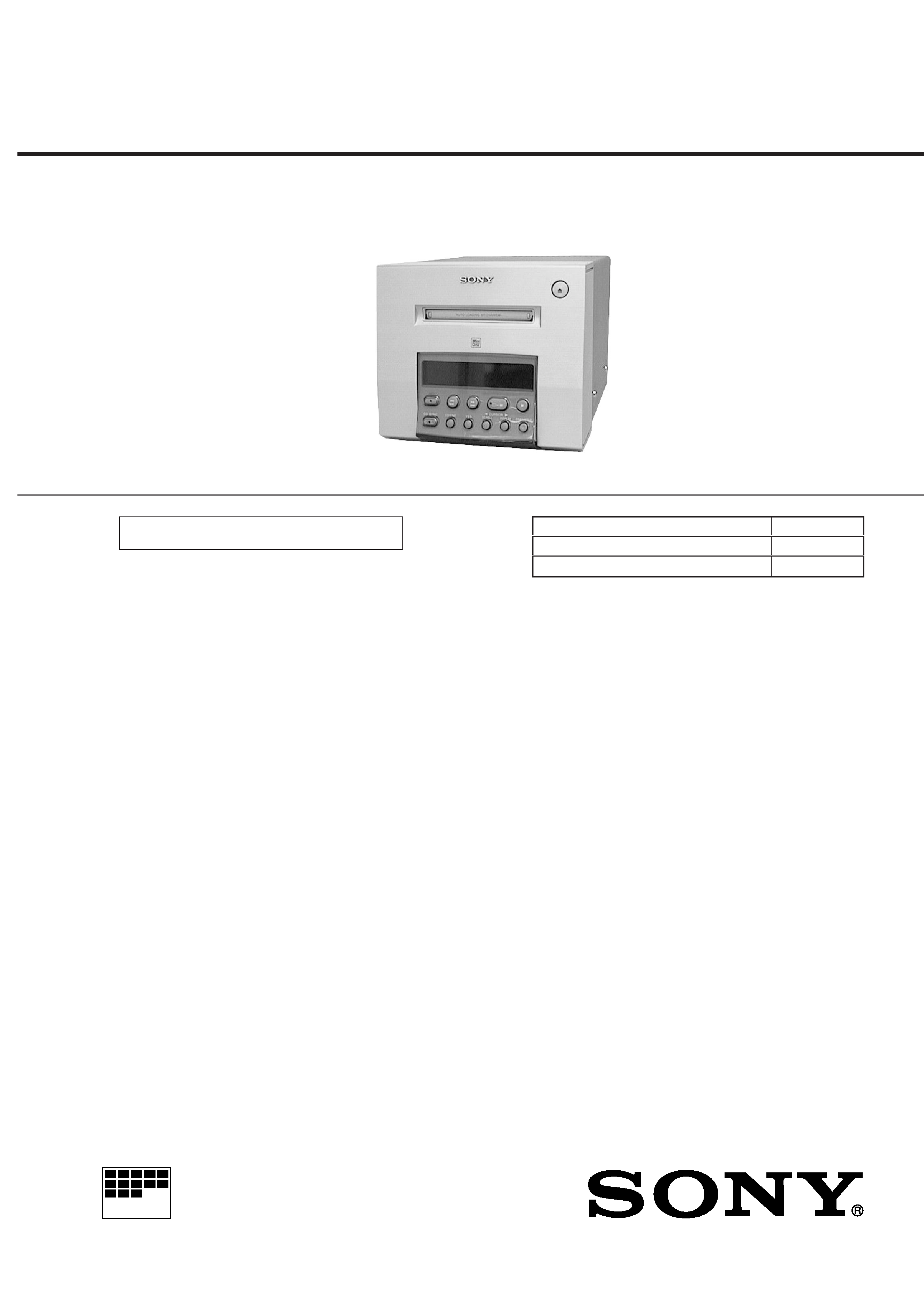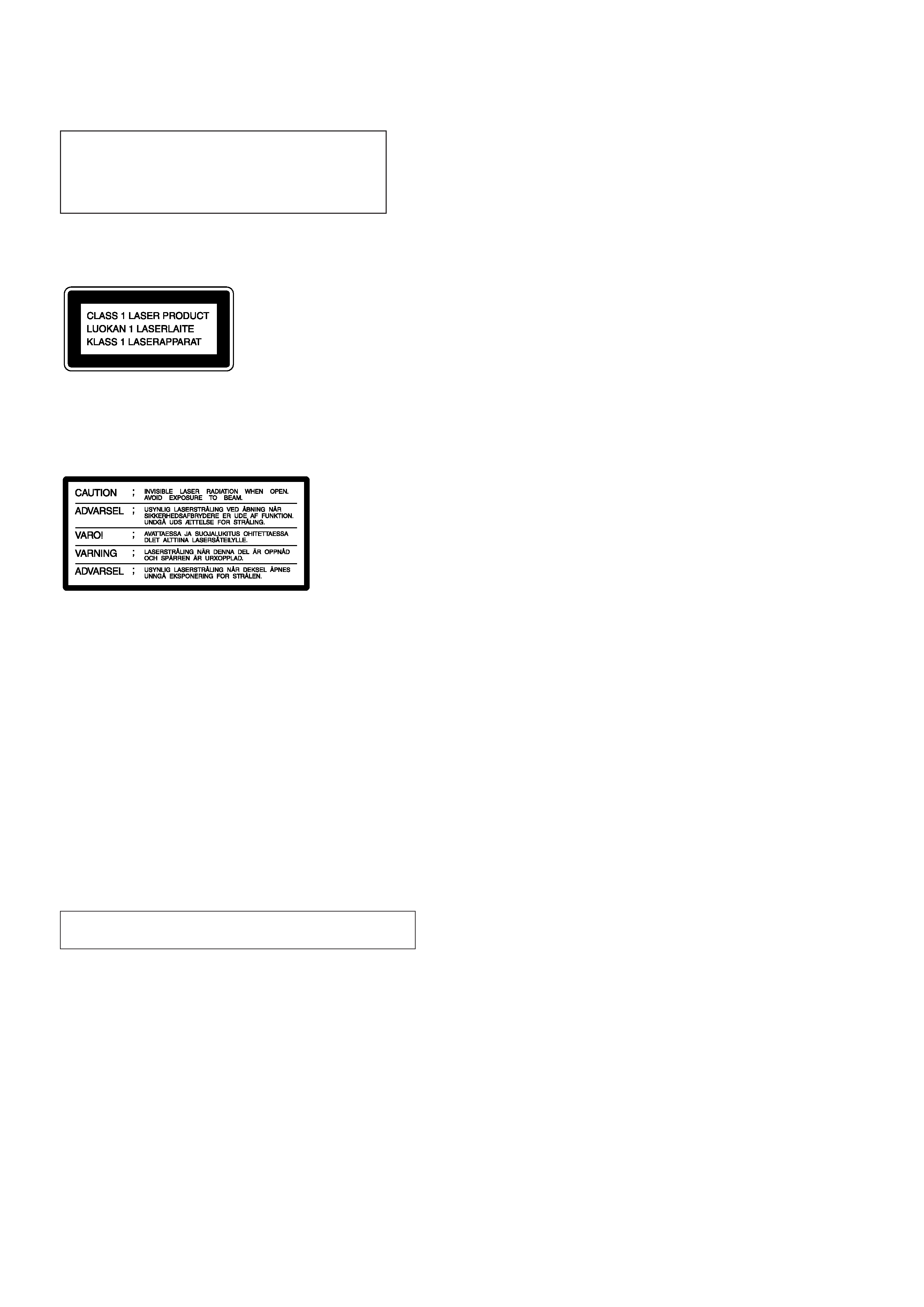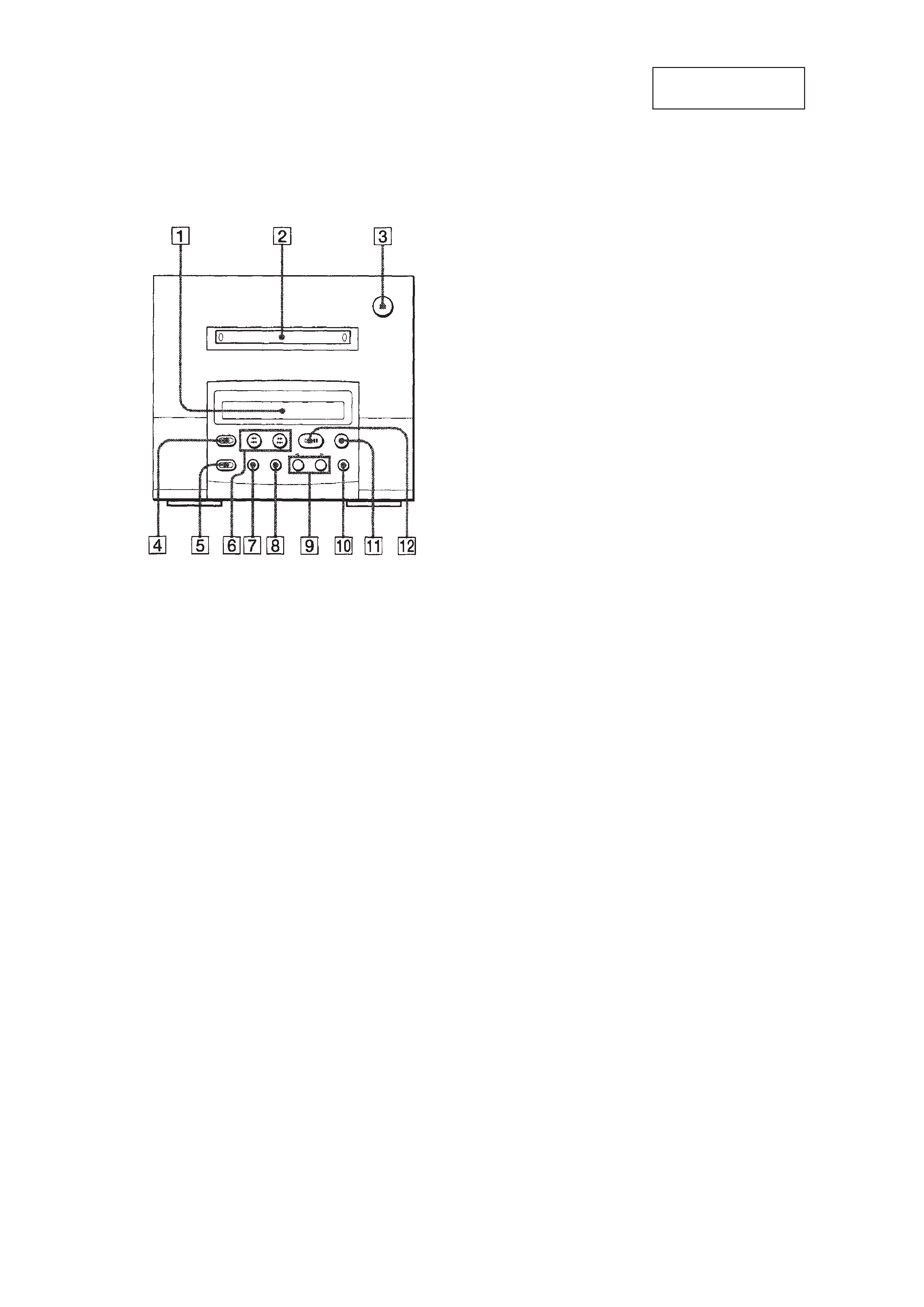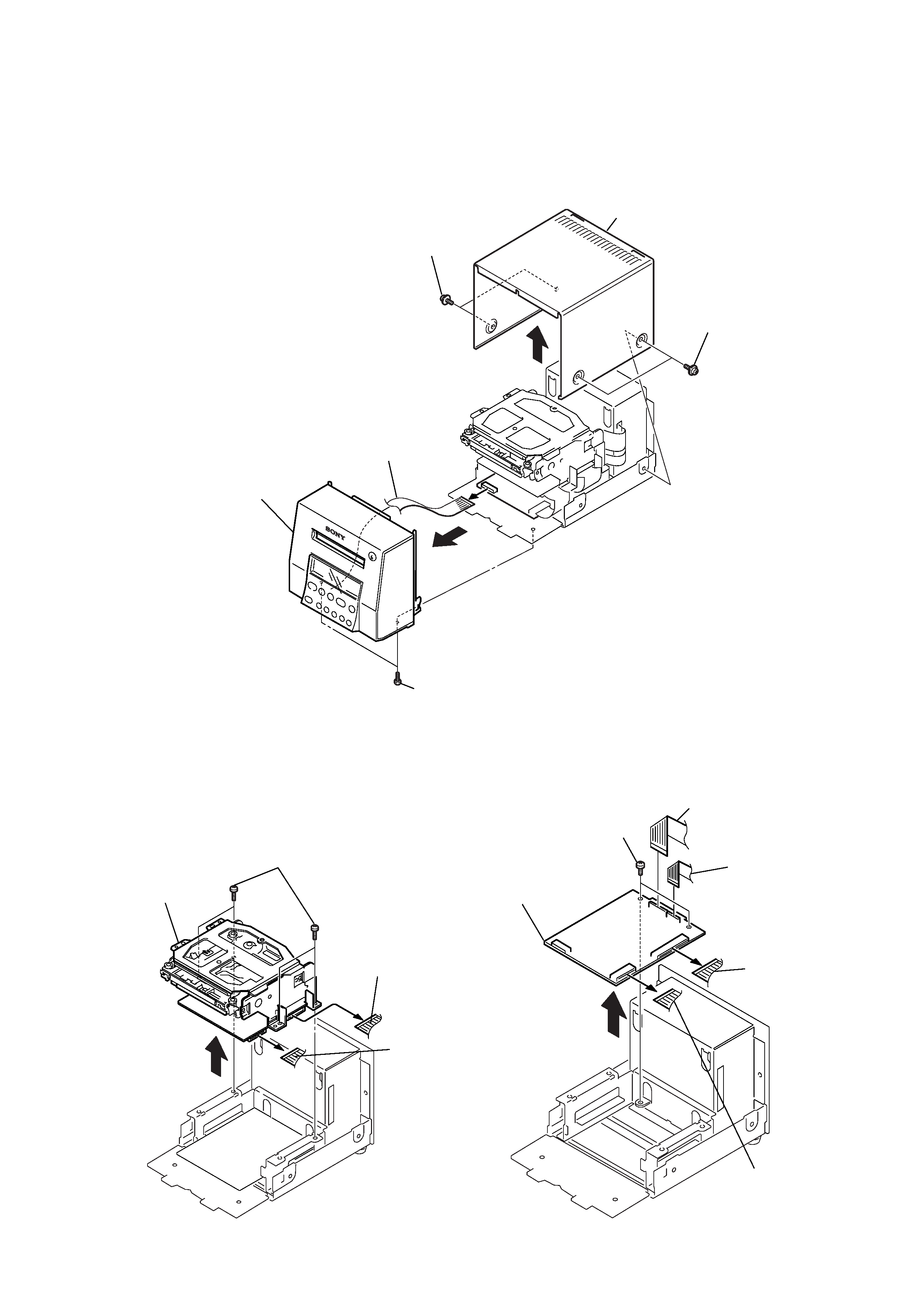
MDS-MX101
SERVICE MANUAL
MINI DISC DECK
MICROFILM
AEP Model
UK Model
E Model
Tourist Model
MDS-MX101 is the optional mini disc
deck that can be used only with section
CMT-101.
U.S and foreign patents licensed from Dolby Labo-
ratories Licensing Corporation.
SPECIFICATIONS
Model Name Using Similar Mechanism
MDS-S38
MD Mechanism Type
MDM-3B
Optical Pick-up Name
KMS-260A/J1N
System
MiniDisc digital audio system
Disc
MiniDisc
Laser
Semicondu2ctor laser (
= 780nm)
Laser output power
Less than 44.6
µW*
*This output is the value measured at a distance of
200 mm from the objective lens surface on the
optical pick-up block with 7 mm aperture.
Laser diodo properties
Material: GaAIAs
Revolutions (CLV)
Approx. 400 rpm to 900 rpm
Error correction
Advance Cross
Interleave Reed Solomon Code (ACIRC)
Sampling frequency
44.1 kHz
Modulation system
EFM (Eight-to-Fourteen Modulation)
Number of channels
2 stereo channels
Frequency response
5 to 20,000 Hz
Signal-to-noise ratio
More than 92 dB (during playback)
Wow and flutter
Below measurable limit
DIGITAL IN (MD
Square optical connector jack, Optical wave length
OPTICAL IN) input/
660 nm
DIGITAL OUT (MD
OPTICAL OUT) output
Dimeansions
Approx. 142
× 125 × 235 mm (w/h/d) incl.
projecting parts and controls
Mass
Approx. 2 kg
Supplied accessory
Digital optical cable (1)

-- 2 --
TABLE OF CONTENTS
1.
SERVICING NOTES
1-1.
Check Mode of Fluorescent Indicator Tube,
Buttons, and LED's ........................................................
3
1-3.
Extension Cable ..............................................................
3
2.
GENERAL ..................................................................
4
3.
DISASSEMBLY
3-1.
Cover and Front Panel ....................................................
5
3-2.
Mechanism Deck ............................................................
5
3-3.
Digital Board ..................................................................
5
3-4.
OPJ Board, Power Board ................................................
6
3-5.
Bracket (T), (L) and (R) .................................................
6
3-6.
BD Board ........................................................................
7
3-7.
Sub Chassis .....................................................................
7
3-8.
Shutter Assembly ............................................................
8
3-9.
Over Write Head .............................................................
8
3-10. Slider Complete Assembly .............................................
9
4.
TEST MODE ........................................................ 10
5.
ELECTRICAL ADJUSTMENTS ......................... 13
6.
DIAGRAMS
6-1.
Circuit Boards Location ................................................. 18
6-2.
Block Diagram ............................................................... 19
6-3.
Printed Wiring Boards
MD Mechanism Deck Section ................................. 22
6-4.
Schematic Diagram
MD Mechanism Deck Section ................................. 25
6-5.
Schematic Diagram Digital Section ......................... 31
6-6.
Printed Wiring Boards Digital Section ..................... 35
6-7.
Schematic Diagram Display Section ........................ 38
6-8.
Printed Wiring Boards Display Section .................... 41
6-9.
Printed Wiring Boards Power Section ...................... 43
6-10. Schematic Diagram Power Section .......................... 45
6-11. IC Block Diagrams ......................................................... 47
6-12. IC Pin Functions ............................................................. 49
7.
EXPLODED VIEWS ................................................ 56
8.
ELECTRICAL PARTS LIST ................................. 60
CAUTION
Use of controls or adjustments or performance of
procedures other than those specified herein may
result in hazardous radiation exposure.
This appliance is classified as a CLASS 1 LASER product.
The CLASS 1 LASER PRODUCT MARKING is located on
the rear exterior.
Laser component in this product is capable of emitting radiation
exceeding the limit for Class 1.
The following caution label is located inside the unit.
NOTES ON HANDLING THE OPTICAL PICK-UP
BLOCK OR BASE UNIT
The laser diode in the optical pick-up block may suffer electrostatic
break-down because of the potential difference generated by the
charged electrostatic load, etc. on clothing and the human body.
During repair, pay attention to electrostatic break-down and also
use the procedure in the printed matter which is included in the
repair parts.
The flexible board is easily damaged and should be handled with
care.
NOTES ON LASER DIODE EMISSION CHECK
The laser beam on this model is concentrated so as to be focused on
the disc reflective surface by the objective lens in the optical pick-
up block. Therefore, when checking the laser diode emission,
observe from more than 30 cm away from the objective lens.
Notes on chip component replacement
· Never reuse a disconnected chip component.
· Notice that the minus side of a tantalum capacitor may be damaged
by heat.
Flexible Circuit Board Repairing
· Keep the temperature of the soldering iron around 270 °C during
repairing.
· Do not touch the soldering iron on the same conductor of the
circuit board (within 3 times).
· Be careful not to apply force on the conductor when soldering or
unsoldering.
CAUTION
Danger of explosion if battery is incorrectly replaced.
Replace only with the same or equivalent type recommended by
the manufacturer.
Discard used batteries according to the manufacturer's instructions.

-- 3 --
SECTION 1
SERVICING NOTES
1-1. CHECK MODE OF FLUORESCENT INDICATOR
TUBE, BUTTONS, AND LEDS
Setting the Check Mode:
This mode is activated by inserting the AC power cord of the PFJ-
1 power supply jig (or HCD-101) into AC wall outlet while pressing
the REC button and the CHARACTER button. When this mode
started, the fluorescent indicator tube and LEDs are all turned on.
1-1-1. Button Check Mode (Key Check)
When the respective buttons (12 buttons are used in total)
are pressed while all tube and LEDs are turned on, the
display area which corresponds to the pressed button, is
turned off. This mode ends by pressing the CD SYNC button
at last.
1-1-2. Fluorescent Indicator Tube Check Mode (Segment
Check)
When the button check mode ends, [Segment Check]
appears and the respective dots of the 12-digit, 5 x 7 segment
fluorescent tube are lit every other dot. This mode ends by
pressing the CD SYNC button at last.
1-1-3. Fluorescent Indicator Tube Check Mode (Scroll Check)
When the segment check ends, [Scroll Check] appears.
When the SCROLL button is pressed, the displayed letter
scrolls to the left one letter after another. When all letters
are scrolled, [end] appears. Press YES button to return to
the normal operating mode.
1-2. EXTENSION CABLE
The two types of extension cable are available during repair of this
set. The extension cable (part code no. J-2501-086-A) is available
to connect CN103 of the BD board and CN200 of the DIGITAL
board. The extension cable (part code no. J-2501-103-A) is available
to connect CN102 of the BD board and CN201 of the DIGITAL
board.
CN102
CN103
CN200
CN201
Extension Cable
(J-2501-086-A)
Extension Cable
(J-2501-103-A)
-- BD board (Conductor side) --
-- DIGITAL board (Component side) --
SERVICENG NOTE
·
Supplying power during servicing
This equipment cannot operate without using a separate power supply. Connect the machine to the HCD-101. To apply power set the
SYSTEM POWER switch of HCD-101.
When other units are not available use the PFJ-1 power supply jig.
When using the PFJ-1, press the POWER switch of the conversion board to turn on the power.
[Connection Diagram]
PFJ-1
(Power Supply jig)
POWER SW
Connector Cable 17P
(Supplied with set)
FH-E939, 838, 737,
MHC-6600, 5600,
CDP/TC
Conversion Board
(J-2501-144-A)
* when checking the recording
function of MDS-MX101, select
any function other than MD using
the Function key of the conversion
board before check.
SYSTEM CONTROL
Set
Power Function

-- 4 --
SECTION 2
GENERAL
This section is extracted
from instruction manual.
1 Display window
2 MD slot
3 6 EJECT button
4 r REC button
5 CD SYNC button
6 = 0 (finding a point in a track/
fast backward) button
) + (finding a point in a track/
fast forward) button
7 EDIT/NO button
8 YES button
9 SCROLL button, DISPLAY button/
?CURSOR/ button
0 CHARACTER button
!¡ p (stop) button
!TM ^ (play/pause) button

-- 5 --
SECTION 3
DISASSEMBLY
Note :
Follow the disassembly procedure in the numerical order given.
3-1.
COVER AND FRONT PANEL
3-3.
DIGITAL BOARD
3-2.
MECHANISM DECK
1 Four Screws
(BVTT 3x8)
4 Mechanism deck
2 Flat type wire (29Core)
(CN102)
3 Flat type wire (19Core)
(CN103)
5 Two screws
(BVTT 3x8)
3 Flat type wire (23Core)
(CN203)
2 Flat type wire (29Core)
(CN201)
1 Flat type wire (19Core)
(CN200)
6 Digital board
4 Flat type wire (13Core)
(CN204)
1 Two screws (Case)
1 Two screws (Case)
4 Flac type wire (16Core)
(CN202)
5 Front Panel
3 Two screws (BVTP 3x8)
2 Cover
